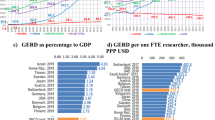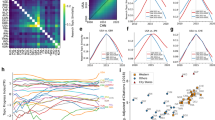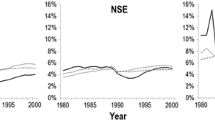Abstract
This paper presents an empirical study of the evolutionary patterns of national disciplinary profiles in research using a dataset extracted from Scopus covering publications from 45 nations for the period 1996–2015. Measures of disciplinary specializations and statistical models are employed to examine the distribution of disciplinary specializations across nations, the patterns of structural changes in the world’s disciplinary profiles, and the evolutionary patterns of research profiles in individual nations. It is found that, while there has been a continuous process of convergence in national research profiles, nations differ greatly in their evolutionary patterns. Changes in national disciplinary profiles are decomposed into the regression effect and the mobility effect and both effects are analyzed for individual nations. The G7 and the BRICs countries are used as cases for the in-depth scrutiny. Policy implications based on the findings and directions for future research are discussed.





Similar content being viewed by others
References
Aksnes, D. W., van Leeuwen, T. N., & Sivertsen, G. (2014). The effect of booming countries on changes in the relative specialization index (RSI) on country level. Scientometrics, 101(2), 1391–1401.
Amendola, G., Guerrieri, P., & Padoan, P. C. (1998). International patterns of technological accumulation and trade. In D. Archibugi & J. Michie (Eds.), Trade, Growth and Technical Change (pp. 141–167). Cambridge: Cambridge University Press.
Bongioanni, I., Daraio, C., Moed, H. F., & Ruocco, G. (2014a). Disciplinary profiles and performance of research systems: A world comparison at the country level. In Proceedings of the science and technology indicators conference 2014 Leiden “Context Counts: Pathways to Master Big and Little Data (pp. 50–63).
Bongioanni, I., Daraio, C., & Ruocco, G. (2014b). A quantitative measure to compare the disciplinary profiles of research systems and their evolution over time. Journal of Informetrics, 8(3), 710–727.
Brigham, E. F., & Houston, J. F. (2016). Fundamental of financial management (14th ed., p. 29). Boston, MA: Cengage Learning.
Cantwell, J. (1989). Technological innovation and multinational corporations (pp. 16–48). Oxford: Blackwell.
Dalum, B., Laursen, K., & Villumsen, G. (1998). Structural change in OECD export specialisation patterns: de-specialisation and ‘stickiness’. International Review of Applied Economics, 12(3), 423–443.
Glänzel, W. (2000). Science in Scandinavia: A bibliometric approach. Scientometrics, 48(2), 121–150.
Glänzel, W., & Schlemmer, B. (2007). National research profiles in a changing Europe (1983–2003). An exploratory study of sectoral characteristics in the Triple Helix. Scientometrics, 70(2), 267–275.
Horlings, E. & van den Besselaar, P. (2013). Convergence in science growth and structure of worldwide scientific output, 1993–2008. Rathenau Instituut, Working Paper 1301.
Hu, X., & Rousseau, R. (2009). A comparative study of the difference in research performance in biomedical fields among selected Western and Asia Pacific countries. Scientometrics, 81(2), 475–491.
Johns, C. M., & Inwood, G. J. (2014). Theories of policy change and a four-part theoretical framework for comparative analysis. In G. J. Inwood & C. M. Johns (Eds.), Commissions of inquiry and policy change: A comparative analysis, Chapter 2 (pp. 20–48). Toronto: University of Toronto Press.
King, D. A. (2004). The scientific impact of nations. Nature, 430(6997), 311–316.
Laursen, K. (2015). Revealed comparative advantage and the alternatives as measures of international specialization. EurAsia Pacific Business Review, 5(1), 99–115.
Mongeon, P., & Paul-Hus, A. (2016). The journal coverage of web of science and Scopus: A comparative analysis. Scientometrics, 106(1), 213–228.
Nederhof, A. J. (1988). The validity and reliability of evaluation of scholarly performance. In A. F. J. Van Raan (Ed.), Handbook of quantitative studies of science and technology, Chapter 7 (pp. 193–228). London: Elsevier Science Pub Co.
Radosevic, S., & Yoruk, E. (2014). Are there global shifts in the world science base? Analysing the catching up and falling behind of world regions. Scientometrics, 101(3), 1897–1924.
Sala-i-Martin, X. X. (1996). The classical approach to convergence analysis. The Economic Journal, 106(437), 1019–1036.
Schubert, A., Glänzel, W., & Braun, T. (1989). Scientometric datafiles. A comprehensive set of indicators on 2649 journals and 96 countries in all major science fields and subfields 1981–1985. Scientometrics, 16(1–6), 3–478.
SCImago. (2007). SJR – SCImago Journal & Country Rank. 20 August 2016. http://www.scimagojr.com.
Scopus. (2016). Content Coverage Guide, January 2016. Accessed 25 Aug 2016.
Tijssen, R. J. W. (1992). Cartography of science: Scientometric mapping with multidimensional scaling methods. Leiden: DSWO Press.
van Leeuwen, T. (2004). Descriptive versus evaluative bibliometrics. In H. F. Moed, W. Glänzel, & U. Schmoch (Eds.), Handbook of quantitative science and technology research (pp. 373–388). Dordrecht: Springer.
van Raan, A. F. (2004). Measuring science. In H. F. Moed, W. Glänzel, & U. Schmoch (Eds.), Handbook of quantitative science and technology research (pp. 19–48). Dordrecht: Springer.
van Raan, A. F. (2006). Statistical properties of bibliometric indicators: Research group indicator distributions and correlations. Journal of the American Society for Information Science and Technology, 57(3), 408–430.
van Raan, F. J. (2014). Advances in bibliometric analysis: Research performance assessment and science mapping. In W. Blockmans, L. Engwall, & D. Weaire (Eds.), Bibliometrics: Use and abuse in the review of research performance (Vol C) (pp. 17–28). Portland: Portland publishers.
Yang, L. Y., Yue, T., Ding, J. L., & Han, T. (2012). A comparison of disciplinary structure in science between the G7 and the BRIC countries by bibliometric methods. Scientometrics, 93(2), 497–516.
Zhou, Q., Rousseau, R., Yang, L., Yue, T., & Yang, G. (2012). A general framework for describing diversity within systems and similarity between systems with applications in informetrics. Scientometrics, 93(3), 787–812.
Acknowledgement
The author is grateful to the two anonymous reviewers for their valuable comments and constructive suggestions.
Author information
Authors and Affiliations
Corresponding author
Rights and permissions
About this article
Cite this article
Li, N. Evolutionary patterns of national disciplinary profiles in research: 1996–2015. Scientometrics 111, 493–520 (2017). https://doi.org/10.1007/s11192-017-2259-4
Received:
Published:
Issue Date:
DOI: https://doi.org/10.1007/s11192-017-2259-4




